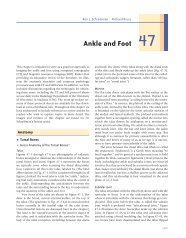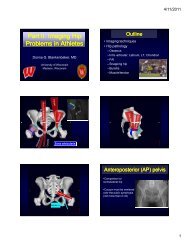Drugs for treatment of contrast reaction - Department of Radiology
Drugs for treatment of contrast reaction - Department of Radiology
Drugs for treatment of contrast reaction - Department of Radiology
You also want an ePaper? Increase the reach of your titles
YUMPU automatically turns print PDFs into web optimized ePapers that Google loves.
UNIVERSITY OF WISCONSIN DEPARTMENT OF RADIOLOGY, POLICY FOR TREATMENT<br />
OF NONIONIC RADIOGRAPHIC CONTRAST MATERIAL EXTRAVASATIONS<br />
1. Immediate cessation <strong>of</strong> injection when a problem is detected – edema at injection sight, pressure, pain,<br />
burning, numbness or other local complaints, and/or lack <strong>of</strong> central <strong>contrast</strong> bolus on images<br />
2. Technologist or nursing staff should immediately in<strong>for</strong>m the responsible faculty, fellow, or on-call<br />
resident. The faculty staff MD is ultimately responsible.<br />
3. Initial <strong>treatment</strong> can include:<br />
• Elevation <strong>of</strong> affected extremity above the heart<br />
• Warm or cold packs (per physician discretion) to the affected site – repeated as required<br />
• Intermittent compression <strong>of</strong> affected site by manual compression or an ace wrap (per physician<br />
discretion)<br />
• Observation – frequency ,site, and available follow-up dependent on patient’s symptoms<br />
(<strong>Radiology</strong> department or patient’s clinic or physician’s <strong>of</strong>fice)<br />
• Call referring physician or clinic <strong>for</strong> any extravasation over 50 mL and instruct them as to<br />
follow-up –<br />
Fax Health Facts<br />
• Educate patient about signs <strong>of</strong> tissue compromise, and advise to seek medical attention as per #5<br />
4. Immediate plastic surgery consultation <strong>for</strong> any <strong>of</strong> the following indications:<br />
• Known s<strong>of</strong>t tissue extravasated volume exceeds 100 mL <strong>of</strong> nonionic <strong>contrast</strong> material (consultation<br />
at smaller volumes <strong>of</strong> extravasation may be appropriate in the pediatric patient)<br />
• Skin blistering<br />
• Altered tissue perfusion (decreased capillary refill in the region or distal to the injection site)<br />
• Increasing pain after 2-4 hours<br />
• Change in sensation distal to site <strong>of</strong> extravasation<br />
5. Patient instructed to watch <strong>for</strong> the following (patient also given Health Facts) and call their physician<br />
(after hours if patient’s physician not available, 608-262-0143 and ask <strong>for</strong> the radiology resident on call)<br />
<strong>for</strong>:<br />
• Residual pain<br />
• Blistering<br />
• Redness or other skin color change<br />
Hardness<br />
• Increased or decreased temperature <strong>of</strong> skin at extravasation site (compared with temperature <strong>of</strong> skin<br />
elsewhere)<br />
• Change in sensation – distal to the extravasation<br />
6. Follow-up phone calls by nurse or radiologist as appropriate<br />
7. Documentation<br />
• Complete hospital occurrence screen <strong>for</strong>m <strong>for</strong> any confirmed and significant extravasation<br />
• Place a note in the patient’s chart if available
12. DRUG SELECTION FOR CONTRAST REACTION<br />
ADULT<br />
REACTION MEDICATION DOSAGE<br />
BRONCHOSPASM<br />
LARYNGEAL<br />
EDEMA<br />
METAPROTERENOL<br />
(ALUPENT) INHALER<br />
2 - 4 puffs<br />
May need higher doses<br />
Monitor heart rate.<br />
10 L / minute<br />
OXYGEN<br />
EPINEPHRINE sub Q 1:1,000 0.3 - 0.5<br />
mL<br />
IV 1:10,000 1mL<br />
q 3 - 5 minutes, not to<br />
exceed 5 mL in 15 min.<br />
PULMONARY<br />
EDEMA<br />
HYPOTENSION<br />
HIVES<br />
SIT PATIENT UP. OXYGEN BY MASK. Securing the<br />
airway is mandatory. If available staff is inexperienced<br />
in intubation then a code should be called immediately.<br />
Vigorous hydration with saline.<br />
Elevate legs.<br />
DIPHENHYDRAMINE<br />
(BENADRYL)<br />
(induces drowsiness and<br />
should be used with<br />
discretion in patients who<br />
are driving).<br />
25 – 50 mg IV<br />
25 – 50 mg IM<br />
VASOVAGAL<br />
REACTION<br />
SEIZURE<br />
HYPERTENSIVE<br />
CRISIS<br />
ATROPINE<br />
DIAZEPAM<br />
(VALIUM)<br />
CLONIDINE<br />
Last updated 2/10/06<br />
0.5 – 1 mg IV to<br />
maximum dose <strong>of</strong> 2 mg<br />
5 – 10 mg IV push; 30 mg<br />
maximum dose.<br />
200 mcg (0.2mg)<br />
or two 100 mcg tablets<br />
Bite, chew, and swallow.
PEDIATRIC<br />
Last updated 2/10/06<br />
REACTION MEDICATION DOSAGE<br />
BRONCHOSPASM<br />
(MODERATE)<br />
ALBUTEROL nebulization ⇒<br />
2.5 mg albuterol in 3ml NS<br />
(prediluted) nebulization<br />
OXYGEN<br />
⇒<br />
10-15 L/min blow by or face<br />
mask<br />
BRONCHOSPASM<br />
(SEVERE)<br />
ALBUTEROL nebulization ⇒<br />
and/or<br />
2.5 mg albuterol in 3 ml NS<br />
(prediluted) nebulization<br />
EPINEPHRINE (1:1000)<br />
OXYGEN<br />
⇒<br />
⇒<br />
0.01 mg/kg/dose (0.01 ml/kg)<br />
SQ (max dose 0.5 ml)<br />
10-15 L/min blow by or face<br />
mask<br />
LARYNGEAL EDEMA<br />
EPINEPHRINE (1:1000) ⇒<br />
and/or<br />
RACEMIC EPINEPHRINE ⇒<br />
(RE) (2.25%) nebulization<br />
0.01 mg/kg/dose (0.01 ml/kg)<br />
SQ (max dose 0.5 ml)<br />
0.05 mL/kg up to 0.5 mL ml RE<br />
in 3ml NS nebulization<br />
OXYGEN<br />
⇒<br />
10-15 l/min blow by or face mask<br />
PULMONARY EDEMA<br />
HYPOTENSION<br />
SIT PATIENT UP.<br />
OXYGEN 10-15 L/min by mask<br />
NORMAL SALINE 10-20 ml/kg slow IV push over ~5-10 min<br />
TRENDELENBERG POSITION<br />
HIVES<br />
DIPHENHYDRAMINE ⇒<br />
(BENEDRYL)<br />
1 mg/kg IV per dose<br />
If severe<br />
EPINEPHRINE (1:1000)<br />
⇒<br />
0.01 mg/kg/dose (0.01 ml/kg)<br />
0.02 SQ (max dose 0.05 ml)<br />
VASOVAGAL REACTION ATROPINE ⇒ 0.02 mg/kg IV<br />
Maximum dose <strong>of</strong> 1 mg<br />
Minimum dose <strong>of</strong> 0.1 mg<br />
SEIZURE<br />
DIAZEPAM<br />
(VALIUM)<br />
⇒<br />
0.2 - 0.3 mg/kg slow IV push per<br />
dose.<br />
may repeat in 5-10 min.<br />
LORAZEPAM<br />
⇒<br />
0.01 mg/kg IV per dose
















